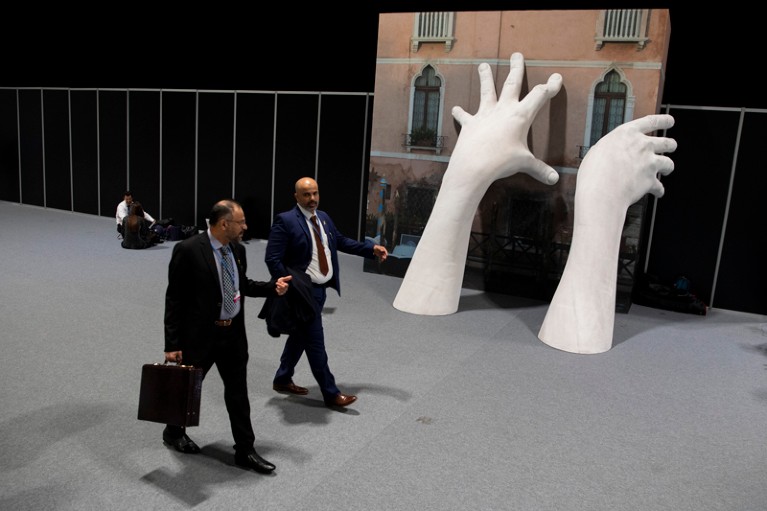
Developed countries must accept that some of the world’s most vulnerable people are experiencing extreme climate effects because of their historical emissions — as exemplified in this sculpture at the Madrid talks.Credit: Pablo Blazquez Dominguez/Getty
“There is no sign of greenhouse-gas emissions peaking in the next few years.”
In an ideal world, such a stark warning — issued by the United Nations Environment Programme (UNEP) — would be enough to persuade delegates attending this week’s climate talks in Madrid to take stronger action against the dangers of climate change. But the two-week meeting is unlikely to yield such results. Negotiators representing the world’s governments are more likely to postpone the hard decisions until next year’s talks in Glasgow, UK, when nations are scheduled to improve on the emissions-reduction pledges they set as part of the 2015 Paris climate agreement.
Negotiators need to solve a number of competing problems that date back to the earliest climate talks in the 1990s and for which there are no straightforward solutions.
First, there must be a step-change in efforts to reduce emissions and keep warming to within 2 °C of pre-industrial temperatures. Here, there is halting progress, although momentum is starting to build towards a global commitment to net-zero emissions by 2050.
Emissions from wealthier nations seem to have stabilized, according to the latest UNEP report. But current pledges to reduce emissions are still projected to result in at least 3 °C of warming, and most developed countries are not even on track to meet those commitments.
Carbon markets shape agenda at UN climate summit
More drastic reductions must not, however, neglect the development needs of the poorest communities — those lacking access to sufficient food, water, health care and electric power. Progress here has been scant. As we reported in September, developed nations have failed to fulfil their pledges to provide funding to help poorer countries protect themselves. This is despite the fact that it is their past emissions that are contributing to the extreme climate effects . This funding would also enable poorer nations to continue to industrialize, but use less carbon in the process.
In 2010, developed countries pledged US$100 billion annually by 2020 towards such help. Some $9.8 billion was pledged in October at a donors’ conference in Paris, but the United States, which is in the process of withdrawing from the Paris agreement, was notable in its absence.
These are some of the reasons why emissions from developing nations show few signs of tailing off. China has only just caught up with developed states, and its per-capita emissions are now close to those of Japan and the European Union. Its emissions from coal are projected to rise further still.
Climate tipping points — too risky to bet against
The science shows hard truths. If all countries accept the consensus view of scientists, as most say they do, then by 2030, emissions must be no more than 50% of current levels to keep warming to below 2 °C. That would need more than just net-zero emissions by 2050 — and include a swifter end to coal-fired power and the acceleration of renewable energy and electric-vehicle development. Much more funding would also be required, so that developing countries can both decarbonize and protect vulnerable populations.
As campaigners — and, increasingly, younger generations — urge their national delegates to take real action against climate change, they must also urge their governments to back their pledges with cash for the poorest. The tension between ambition to reduce emissions and the demands of equity must be resolved if international climate talks are to reach agreement.

 Carbon markets shape agenda at UN climate summit
Carbon markets shape agenda at UN climate summit
 Climate tipping points — too risky to bet against
Climate tipping points — too risky to bet against
 Where climate cash is flowing and why it’s not enough
Where climate cash is flowing and why it’s not enough




